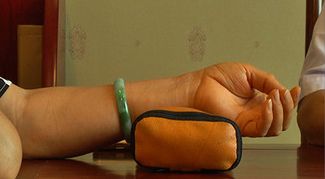Friends who have watched the TV drama “Empresses in the Palace” may remember a scene where the imperial physician concentrates and takes the pulse of the empress, then suddenly kneels and exclaims: “Congratulations, Your Majesty! The pulse is slippery, indicating a joyful sign.” At this point, everyone understands: the empress is pregnant. Therefore, when a man is diagnosed with a slippery pulse, his inner fear is understandable. However, it is important to note that while a slippery pulse is a primary pulse sign of pregnancy, not all slippery pulses indicate pregnancy! A woman without illness who presents a slippery pulse can be judged as pregnant (pregnancy months 2-9). A normal person’s pulse may be slightly slippery and gentle, indicating a harmonious balance of Ying and Wei (nutritive and defensive Qi) and abundant Qi and blood.


 1
1
What Exactly is a Slippery Pulse?
A “slippery pulse” refers to a pulse that flows smoothly and is round and slick, resembling the way pearls roll on a jade plate. When taking the pulse, if it is slippery, it feels like a row of bubbles or small iron beads passing through the practitioner’s ring finger, middle finger, and index finger in quick succession.

 2
2
Who Else Might Exhibit a Slippery Pulse?
1. Those with food stagnation may present a slippery pulse.
2. Those with excess heat may present a slippery pulse.
3. Those with phlegm and fluid retention may present a slippery pulse.
4. Those with deficiency may present a slippery pulse.

 3
3
The slippery pulse is one of the six basic pulse types, and it rarely appears in isolation. Here, we will discuss several common pulse types that may occur simultaneously with a slippery pulse.
Slippery and Floating
A slippery pulse indicates phlegm, while a floating pulse indicates wind; a slippery and floating pulse suggests the presence of wind-phlegm.
Slippery and Deep
A slippery pulse indicates phlegm, while a deep pulse indicates internal conditions; a slippery and deep pulse suggests the presence of turbid phlegm internally.
Slippery and Slow
A slippery pulse indicates phlegm, while a slow pulse indicates stagnation of Qi and blood; a slippery and slow pulse suggests the accumulation of phlegm-dampness.
Slippery and Rapid
A slippery pulse indicates phlegm, while a rapid pulse indicates heat; a slippery and rapid pulse suggests heat symptoms when strong.

 4
4
What Kind of Pulse is Truly a ‘Joyful Pulse’?
A joyful pulse can generally be detected 4-6 weeks (forty to fifty days) after a missed period. When palpated, it flows smoothly and is round like rolling beads. If pregnant, all three fingers (ring, middle, and index) can distinctly feel a lively pulse; if any of the three fingers does not feel the pulse, it is not a pregnancy pulse.

Scan the QR code below
Follow us for your health guidance


Does the editor love you all?
Come and follow us!

